
A | B | C | D | E | F | G | H | CH | I | J | K | L | M | N | O | P | Q | R | S | T | U | V | W | X | Y | Z | 0 | 1 | 2 | 3 | 4 | 5 | 6 | 7 | 8 | 9
| Part of a series on |
| Jewish culture |
|---|
 |
| Mythology |
|---|
Jewish mythology is the body of myths associated with Judaism. Elements of Jewish mythology have had a profound influence on Christian mythology and on Islamic mythology, as well as on Abrahamic culture in general.[1] Christian mythology directly inherited many of the narratives from the Jewish people, sharing in common the narratives from the Old Testament. Islamic mythology also shares many of the same stories; for instance, a creation-account spaced out over six periods, the legend of Abraham, the stories of Moses and the Israelites, and many more.
Tanakh
The writings of the biblical prophets, including Isaiah, Ezekiel, and Jeremiah, express a concept of the divine that is distinct from the mythologies of its neighbors. Instead of seeing the god of Israel as just one national god, these writings describe Yahweh as the one god of the universe.
The prophetic writings condemned Hebrew participation in nature worship, and did not completely identify the divine with natural forces.
Through the prophets' influence, Jewish theology increasingly portrayed God as independent from nature and acting independently of natural forces. Instead of eternally repeating a seasonal cycle of acts, Yahweh stood outside nature and intervened in it, producing new, historically unprecedented events; Eliade wrote: "That was theophany of a new type, hitherto unknown—the intervention of Jahveh in history. It was therefore something irreversible and unrepeatable. The fall of Jerusalem does not repeat the fall of Samaria: the ruin of Jerusalem presents a new historic theophany, another 'wrath' of Jahveh. Jahveh stands out from the world of abstractions, of symbols and generalities; he acts in history and enters into relations with actual historical beings."[2]
Themes and narratives
Creation narrative

Two creation stories are found in the first two chapters of the Book of Genesis. In the first, Elohim, the Hebrew generic word for God, creates the heavens and the earth in six days, then rests on, blesses and sanctifies the seventh. In the second story, God, now referred to by the personal name Yahweh, creates Adam, the first man, from dust and places him in the Garden of Eden, where he is given dominion over the animals. Eve, the first woman, is created from Adam and as his companion. God creates by spoken command and names the elements of the world as he creates them.
Genesis 1:1–2:3 creation order:
- Day 1 – Creation of light (and, by implication, time).
- Day 2 – The firmament. In Genesis 1:17 the stars are set in the firmament.
- Day 3 – Creating a ring of ocean surrounding a single circular continent.[3] God does not create or make trees and plants, but instead commands the earth to produce them.
- Day 4 – God puts "lights" in the firmament to "rule over" the day and the night, referring to the "sun" and "moon".[4]
- Day 5 – Creation of the living creatures.
- Day 6 – Creation of first man, Adam.
- Day 7 – Creation is followed by rest.
In the second story (Genesis 2:4–2:25) the order is different; God created man, the Garden of Eden and planted trees, the living creatures and then the first woman.
The "combat myth"
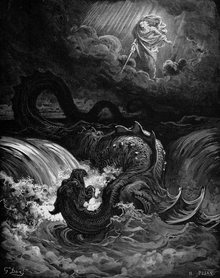
Many of the Hebrews' neighbors had a "combat myth" about the good god battling the demon of chaos; one example of this mytheme is the Babylonian Enûma Eliš.[5] A lesser known example is the very fragmentary myth of Labbu.[6] According to historian Bernard McGinn, the combat myth's imagery influenced Jewish mythology. The myth of God's triumph over Leviathan, a symbol of chaos, has the form of a combat myth.[7] In addition, McGinn thinks the Hebrews applied the combat myth motif to the relationship between God and Satan. Originally a deputy in God's court, assigned to act as mankind's "accuser" (satan means "to oppose" – Hebrew: שָּׂטָן satan, meaning "adversary"), Satan evolved into a being with "an apparently independent realm of operation as a source of evil" – no longer God's deputy but his opponent in a cosmic struggle.[8]
Even the Exodus story shows combat-myth influence. McGinn believes the "Song of the Sea", which the Hebrews sang after seeing God drown the Egyptian army in Yam Suph, includes "motifs and language from the combat myth used to emphasize the importance of the foundational event in Israel's religious identity: the crossing of the Red Sea and deliverance from the Pharaoh".[7] Likewise, Armstrong notes the similarity between pagan myths in which gods "split the sea in half when they created the world" and the story of the Exodus from Egypt, in which Moses splits the Sea of Reeds (the Red Sea) – "though what is being brought into being in the Exodus, is not a cosmos but a people".[9] In any case, the motif of God as the "divine warrior" fighting on Israel's behalf is clearly evident in the Song of the Sea (Ex. 15). This motif recur in poetry throughout the Hebrew Scriptures (I Samuel 2; Zechariah 9:11–16;14:3-8).
Some comparative mythologists think Jewish mythology absorbed elements from pagan mythology. According to these scholars, even while resisting pagan worship, the Jews willingly absorbed elements of pagan mythology.[10]
Origin myth
Adam and Eve
According to the creation narratives in Genesis, Adam and Eve were the first man and woman. In the Book of Genesis of the Hebrew Bible, chapters one through five, there are two creation narratives with two distinct perspectives. In the first, Adam and Eve (though not referenced by name) were created together in God's image and jointly given instructions to multiply and to be stewards over everything else that God had made. In the second narrative, God fashions Adam from dust and places him in the Garden of Eden where he is to have dominion over the plants and animals. God places a tree in the garden which he prohibits Adam from eating the fruit of. Eve is later created from one of Adam's ribs to be Adam's companion.
Garden of Eden

The biblical story of Garden of Eden, most notably in the Book of Genesis chapters 2 and 3, and also in the Book of Ezekiel[11] depicts Adam and Eve as walking around the Garden of Eden naked due to their innocence.[12] The man was free to eat off of any tree in the garden, but forbidden to eat from the tree of knowledge of good and evil. Last of all, the LORD God made a woman (Eve) from a rib of the man to be a companion to the man. However, the serpent tricks Eve into eating fruit from the forbidden tree. Following Eve, Adam broke the commandment and ate of the forbidden fruit. God curses only the serpent and the ground. He prophetically tells the woman and the man what will be the consequences of their sin of disobeying God. Then he banishes "the man" from the Garden of Eden to prevent him from eating also of the tree of life, and thus living for ever. East of the garden there were placed Cherubim, "and a flaming sword which turned every way, to keep the way of the tree of life". (Gen.3:24)
The story of the Garden of Eden makes theological use of mythological themes to explain human progression from a state of innocence and bliss to the present human condition of knowledge of sin, misery, and death.[13]
Tower of Babel
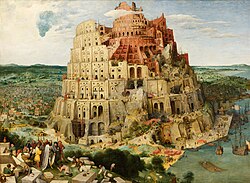
The story of the Tower of Babel explains the origin of different human languages. According to the story, which is recorded in Genesis 11:1–9, everyone on earth spoke the same language. As people migrated from the east, they settled in the land of Shinar (Mesopotamia). People there sought to make bricks and build a city and a tower with its top in the sky, to make a name for themselves, so that they not be scattered over the world. God came down to look at the city and tower, and remarked that as one people with one language, nothing that they sought would be out of their reach. God went down and confounded their speech, so that they could not understand each other, and scattered them over the face of the earth, and they stopped building the city. Thus the city was called Babel.
Flood narrative
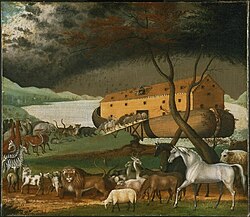
The Genesis flood narrative has similarities to ancient flood stories told worldwide. One of the closest parallels is the Mesopotamian myth of a world flood, recorded in The Epic of Gilgamesh. In the Hebrew Bible flood story (Genesis 6:5–22), God decides to flood the world and start over, due to mankind's sinfulness. However, God sees that a man named Noah was righteous (because he walked with God) and blameless among the people. God instructs Noah to build an ark and directs him to bring at least two of every animal inside the boat, along with his family. The flood comes and covers the world. After 40 days, Noah sends a raven to check whether the waters have subsided, then a dove; after exiting the boat, Noah offers a sacrifice to God, who smells "the sweet savour" and promises never to destroy the earth by water again – making the rainbow a symbol of this promise. Similarly, in the Mesopotamian Epic of Gilgamesh,[14] the bustle of humanity disturbs the gods, who decide to send a flood. Warned by one of the gods, a man named Utnapishtim builds a boat and takes his family and animals inside. After the flood, Utnapishtim sends a dove, then a swallow, then a raven to check whether the waters have subsided. After exiting the boat, Utnapishtim offers a sacrifice to the gods, who smell "the sweet savour" and repent their choice to send the flood.
Another ancient flood myth is the Hindu story of Matsya the fish. According to this story,[15] the god Vishnu takes the form of a fish and warns the ancestor Manu about a coming flood. He tells Manu to put all the creatures of the earth into a boat. Unlike the biblical flood, however, this flood is not a unique event brought on by a divine choice; instead, it's one of the destructions and recreations of the universe that happen at regular intervals in Hindu mythology. This recurrence also happens in Mesopotamian floods or disasters, although is because of the discontent of the gods because of the noise made by humans, told in the Erra Epic.
National myth
The Patriarchs
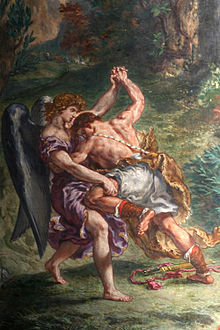
The Patriarchs in Hebrew bible are Abraham, his son Isaac, and Isaac's son Jacob, also named Israel, the ancestor of the Israelites. These three figures are referred to collectively as the patriarchs of Judaism, and the period in which they lived is known as the patriarchal age. The narrative in Genesis revolves around the themes of posterity and land. Abraham is called by God to leave the house of his father Terah and settle in the land originally given to Canaan but which God now promises to Abraham and his progeny. Various candidates are put forward who might inherit the land after Abraham; and, while promises are made to Ishmael about founding a great nation, Isaac, Abraham's son by his half-sister Sarah, inherits God's promises to Abraham. Jacob is the son of Isaac and Rebecca and regarded as a Patriarch of the Israelites as his twelve sons became the progenitors of the "Tribes of Israel".
The Exodus
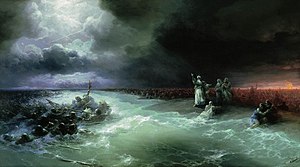
The story of the exodus is told in the books of Exodus, Leviticus, Numbers, and Deuteronomy. The Israelites had settled in the Land of Goshen in the time of Joseph and Jacob, but a new pharaoh arose who enslaved and oppressed the children of Israel. At this time Moses was born; the Pharaoh had commanded that all male Hebrew children born would be drowned in the river Nile, but Moses' mother placed him in an ark and concealed the ark in the bulrushes by the riverbank, where the baby was discovered and adopted by Pharaoh's daughter, and raised as an Egyptian. One day after Moses had reached adulthood he killed an Egyptian who was beating a Hebrew. Moses, in order to escape the Pharaoh's death penalty, fled to Midian.
There, on Mount Horeb, God appeared to Moses as a burning bush revealed to Moses his name YHWH[16] and commanded him to return to Egypt and bring his chosen people (Israel) out of bondage and into the Promised Land.[17] During the journey, God tried to kill Moses, but Zipporah saved his life. Moses returned to carry out God's command, but God caused the Pharaoh to refuse, and only after God had subjected Egypt to ten plagues did the Pharaoh relent. Moses led the Israelites to the border of Egypt, but there God hardened the Pharaoh's heart once more, so that he could destroy the Pharaoh and his army at the Red Sea Crossing as a sign of his power to Israel and the nations.[18]
Zdroj:https://en.wikipedia.org?pojem=Jewish_mythology
Text je dostupný za podmienok Creative Commons Attribution/Share-Alike License 3.0 Unported; prípadne za ďalších podmienok. Podrobnejšie informácie nájdete na stránke Podmienky použitia.
Antropológia
Aplikované vedy
Bibliometria
Dejiny vedy
Encyklopédie
Filozofia vedy
Forenzné vedy
Humanitné vedy
Knižničná veda
Kryogenika
Kryptológia
Kulturológia
Literárna veda
Medzidisciplinárne oblasti
Metódy kvantitatívnej analýzy
Metavedy
Metodika
Text je dostupný za podmienok Creative
Commons Attribution/Share-Alike License 3.0 Unported; prípadne za ďalších
podmienok.
Podrobnejšie informácie nájdete na stránke Podmienky
použitia.
www.astronomia.sk | www.biologia.sk | www.botanika.sk | www.dejiny.sk | www.economy.sk | www.elektrotechnika.sk | www.estetika.sk | www.farmakologia.sk | www.filozofia.sk | Fyzika | www.futurologia.sk | www.genetika.sk | www.chemia.sk | www.lingvistika.sk | www.politologia.sk | www.psychologia.sk | www.sexuologia.sk | www.sociologia.sk | www.veda.sk I www.zoologia.sk
